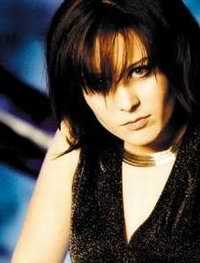Go, first, to the countryside outside of Uppsala, the ancient town nestled to the north of Stockholm in Sweden, where Sofia was born just twenty-two years ago. From the very beginning she was captivated by music -- before the beginning, in fact. "Even when I was in my mother's womb, I used to kick when there was music around that I liked," she laughs. "When a special person played the organ in church, or during a rock concert, I kicked when I liked it."
The church also was a presence in her life. Her father, a minister, was part of a long line of organists whose work was respected throughout Sweden. His work took Sofia and her family to new places every few years; at four-and-a-half she moved with them to Gotland, a wind-blown island off the southeastern coast, in the Baltic Sea. Later they would settle in Karlskrona, a seventeenth-century village that had long been home to her mother's family.
All the while Sofia listened to the music that surrounded her. Before she could even speak she spent hours at her family's piano as her grandfather or her mother played, then took her turn, "not just pushing the keys down," she remembers, "but trying to pick out melodies, one note at a time." The choirs in local churches filled her head with their songs; later, when she was old enough, Sofia would join her father as he traveled to preach before faraway congregations. Eventually she became part of the program, singing before or after his sermons.
Looking back, Sofia considers herself lucky to have been raised within this tradition. "The music in the churches where I grew up was influenced by many different styles," she says. "It was a cultural mix, just like a country where people from many different places live. They'd even have hard rock, with Christian lyrics. I've never been into conservative music, so this was very good for me."
By the time she was fifteen Sofia had also begun creating her own tunes -- mainly ballads, inspired by Whitney Houston and Mariah Carey, and animated by her yearning to experience life beyond the sheltered world she had known. Encouraged by one of her teachers to explore songwriting further, she finished ten songs with lyrics in Swedish, then switched to English as she began to realize that she had something original to say. Once she had crossed the linguistic divide, she never looked back.
"There was a kind of magic in English. You don't really find that magic in your own language, because you use it every day. It's like if you only eat spaghetti, it's not so special, but when you get Chinese food it's really special because you don't eat it every day. Although," she laughs, "they'd be crazy if they felt that way in China."
The taste of magic helped Sofia commit herself fully to music. Again at the urging of her teacher, she agreed to take part in a Swedish pop music competition. Inspired by the musicians with whom she performed, and especially by a pianist whose jazz background expanded her ideas about harmony and song structure, she moved past her concentration on writing ballads. Her experience up to that point gave Sofia a fresh perspective on the more dance-oriented material she now wanted to explore: "It helped me to think more melodically. I had learned a certain kind of groove in the ballads, which I just turned into an upbeat thing. For me, an upbeat song is not just a fast song; it's a good song with a nice groove."
Her explorations had not gone unnoticed. In 1997 scouts from the Swedish Pama label caught one of her performances and invited her to record. Working with Maxe, president of Pama, and his producer Johan Glössner, the seventeen-year-old singer began polishing her songs and writing new ones. A few years later, Janett Jensen from Warner Chappell Scandinavia AB visited the States with a six-song demo, which quickly prompted contacts at Curb to sign Sofia to a distribution deal.
The Sofia Loell tapes were mastered at Portland, Maine's Gateway Mastering Studios by Bob Ludwig, described by music technology writer Paul Verna as "hands-down the most in-demand mastering engineer on the planet," with a client list that includes Jimi Hendrix, Bruce Springsteen, Madonna, Nirvana, and U2. Late in 2001 the first single, "Right Up Your Face," made its appearance; based on an incident involving a close friend who had dumped an oppressive boyfriend, the song is, according to Sofia, "a nice way of saying -- pardon me -- 'Up yours.'"
It is also evidence of an important truth about the music on Sofia Loell: All of it stems from the young artist's experiences or insights into real life. "Music is just one of my interests," she explains. "The other one is people. I'm interested in how people act and react, and how things can affect how you live or what you think. Just to watch people, that's my second big interest. Through the eyes of other people, you learn about yourself as well. That's why I'm not just writing when I make my songs; hopefully, I'm giving something to people too."
